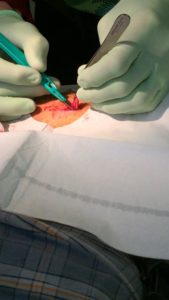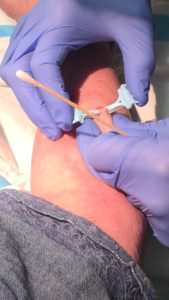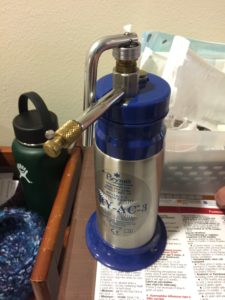I have to remind myself often not to get discouraged or overwhelmed while shadowing Dr. Brunk. It’s important for me to keep in mind that he’s had years of schooling, years of training, and even more years of experience in his profession, so it’s natural that I won’t be able to keep up all the time. All the same, it’s a bit intimidating to observe some of his examinations and realize that I have no grasp on his diagnosis, or even the thought-process he used to get there. Luckily, Dr. Brunk is as passionate a teacher as he is a physician, so he typically senses when the topic is way too far out of my league and tries to give me a brief run down after we’re done with a complex patient.
Truly where I’m able to learn the most is in the interactions between him and his patients. He creates such a relaxed air in all of his appointments, and even the surliest, grumpiest patients have to smile at least once during their examinations. Listening to him is really a master class on communication and I don’t think I could have gotten a better doctor to follow. My favorite patients are actually the ones who don’t speak English and need interpreters with them for their appointments. Dr. Brunk’s charisma breaks the language barrier, and even with a Vietnamese phone interpreter as the medium of speech there was still a nearly tangible connection with his patient.
The patients themselves teach me a lot as well, if indirectly. We met with a relatively older patient who had been born with an imperforate anus and esophageal atresia: a malformed rectum and an incomplete esophagus, respectively. They had been reconstructed multiple times throughout their life, lived with pain and compromise and some gnarly scars, but was there to see us that day for a follow up appointment on their broken arm. The patient had injured themselves by jumping from a waterfall, and was as happy as a clam about it. Despite being born literally incomplete, they chose to lead an exciting and fun life. They traveled, messed around, got hurt, and respected that pain is a natural part of a full life. Many people seem to forget that as they grow older. Many patients we see choose to be victims of their pain. They make it the focus of their lives and limit themselves to it. But for every patient who thinks they’re ready to give up on life, there is a team of dedicated and caring providers that will not give up on them.
All of the healthcare providers I’ve had the pleasure to learn alongside are amazing, genuine people. One day Dr. Brunk told me, “we doctor-people are an odd group,” and he was right. It takes a unique kind of character to commit so completely to the well-being of complete strangers, and it often seems like they care more for their patients than their patients care for themselves. It’s true that they’re paid well for it, but I can attest firsthand, at least for the providers that I have met, that every dollar is hard earned and money is not their motivating factor. On a daily basis Dr. Brunk stays at the office two hours after closing time, completing his patient notes. He could finish them during the day, maybe if he were more efficient; but instead of rushing through his appointments and throwing prescriptions at his patients, he listens to everything they tell him, converses with them, and takes a genuine professional interest in their problems.
My favorite part of the day is the “team huddle” we do every morning before the day starts. Dr. Brunk and the four colleagues in his team (his CMA Simone, his Social Worker Josh, his Case Manager Natalie, and his RN Lynn) review all of the patients coming in for the day and organize a strategy to treat them. It’s really interesting to see the interdisciplinary cooperation play out between all of them. But what’s really fun is the sense of community and family in the room. The best way I can describe the atmosphere of team huddles is to say it feels like when you’re assigned a group project in class, and all of your group members are your friends. That feeling of camaraderie and trust is persistent throughout the week.
Interesting procedures this week include the shaving removals of an actinic keratosis and a suspicious dermatofibroma (typically a benign lesion but Dr. Brunk wanted this one sent in to pathology just in case) and the excision of a residual actinic keratosis, and this time I have pictures! The staff tells me that we’ve been having an unusual number of behavioral health cases lately and the issues people have been coming in for aren’t typically so psychological. The psychology side of the job is very interesting to me so I’m personally okay with the weird streak, and, according to the staff, EMTs and paramedics naturally have to handle a lot of people in need of psychological assistance. Since that’s my end goal for a medical career it’s good for me to have so much exposure to it.
Dr. Brunk’s son graduated high school on Saturday, so he’s taking a week off and going on a trip with him. We had a lovely dinner at his home (my host family are close friends with the Brunks) and I’ll have a week of recreational time ahead. Hiking is still a very abundant activity around here, we went up to Whatcom Falls one day after work, and everywhere is so beautiful. This is continuing to be an amazing trip, until next week, goodbye from Bellingham!

Whatcom Falls (the water has been low lately)




There are no comments published yet.